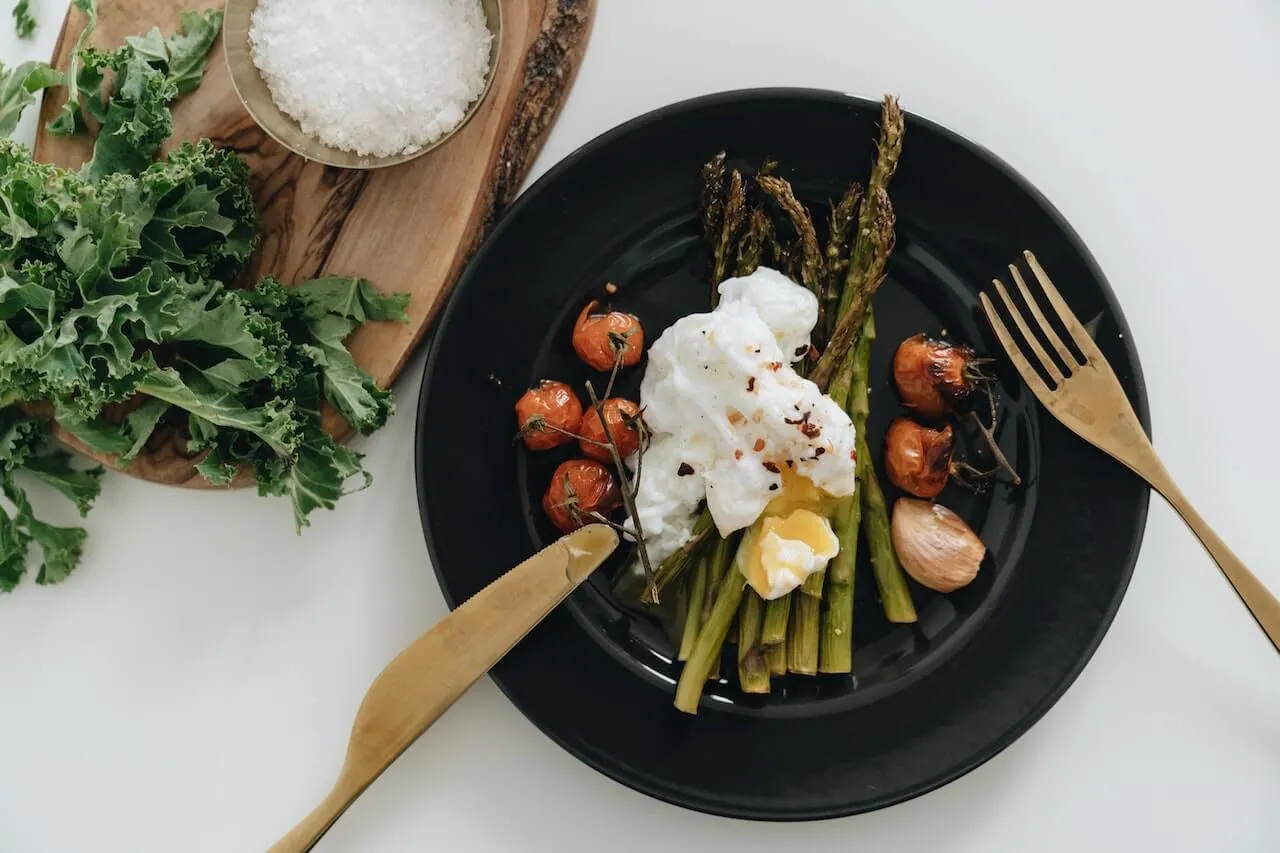Flu is caused by the influenza virus. It affects the respiratory system, targeting the airway and lungs. Flu symptoms include sore throat, cough, stuffy nose, muscle aches, headaches, tiredness, and sometimes fever.
Our immune system fights against microbes, and a healthy and balanced diet is an impactful way to support it. This is even more important when you're sick because most people lose their appetite when they have the flu.
Most people can recover without medication within two weeks. However, some people experience worsening symptoms and develop serious complications. While flu season is coming, this article will help you find nutritious foods and provide tips to get essential nutrients and fluids that support your recovery.
{{mid-cta}}
Chicken Soup

Chicken soup is the go-to home remedy when sick. It's an energy- and protein-rich warm meal that can help you get some nutrients when you don't have much appetite. Although it's not a cure for the flu, it can ease symptoms like a dry throat and congested nose for a while. Additionally, it can provide electrolytes and help with hydration.1
Other warm meals and soups can also help you feel better. Try eating your comfort foods if you don't have much appetite.
Juice

Fruit juices or smoothies make getting calories, vitamins, and minerals easy. Although juicing decreases the fiber you get from eating whole fruit, sometimes fluids can be the only way to get some nutrients when you're sick and have no appetite.
Juicing different fruits and vegetables can provide various vitamins and minerals to support your immune system. However, if you have diabetes, be cautious with juices because they contain much more sugar than whole fruit and lack fiber, which can cause a more significant and sudden increase in blood sugar levels. In this case, a protein-rich vegetable juice (possibly with protein powder) might be a better option.2
Leafy Vegetables

Leafy vegetables are rich in vitamins, minerals, antioxidants, and fiber. Leafy greens include but are not limited to spinach, kale, lettuce, Swiss chard, collard greens, arugula, and bok choy. You can add these to your soups and stews.
However, remember to wash your vegetables thoroughly to prevent gastrointestinal infections while you are already fighting the flu.3
Garlic

Garlic contains antiviral molecules called organosulfur compounds. In vitro (test tube) studies indicate organosulfur compounds may prevent infections; however, human studies are limited.4
Although further research is needed to prove its benefits, it's a great garnish for your meals.
Garlic can at least help you enjoy food more, which is essential when you have no appetite.
Tea

Green and black tea is a good source of catechins, which are antioxidant compounds. Infections can significantly increase inflammation in the body. Antioxidants can support your immune cells and body by decreasing inflammation.5
When sick, your body tends to lose water and become dehydrated, so it's essential to be mindful of caffeine consumption. A cup of green tea or tea contains 20 to 50 milligrams (mg) of caffeine. Although this small amount is okay, drinking too much caffeine can contribute to dehydration.6
Yogurt

Yogurt is a protein-rich food with probiotics. Probiotics are living organisms that can promote gut health. Our gut contains immune cells that play a role in preventing infections. Probiotics can help protect and support these cells, closing the door to microbes and helping with their elimination. Other probiotic-rich foods include kimchi, miso, tempeh, kombucha, and kefir.7
Yogurt is especially great for people who have no appetite when sick. It's high in protein, contains probiotics, and is somewhat liquid. As a breakfast topping, it pairs well with oatmeal and some fruits.
<div class="pro-tip"><strong>Also Read: </strong><a href=yogurt-probiotics>Yogurt Probiotics: The Key to a Happy Gut</a></a>.</div>
Oatmeal

Oatmeal provides good energy and is rich in fiber, containing compounds called β-glucans. These compounds have been shown to enhance specific immune cells that kill microbes. β-glucans can also support beneficial bacteria in the gut. However, the evidence in humans is insufficient to say that oats can be antiviral for humans.8
Banana

Bananas are commonly given to people with diarrhea while sick. Green bananas, which are less sweet and less mature than ripe bananas, can be beneficial for diarrhea. They also have a lower glycemic index, making them more suitable for people with diabetes.9
Spices

Spices enhance the flavor of meals. Tasty foods can be helpful for people with no appetite when they're sick. Spices come in a great variety, and everyone can tolerate them differently.
If you're experiencing an upset stomach while having the flu, opting for milder spices, such as black pepper, can be beneficial. However, if you can tolerate them, you don't have to cut out spicy foods.
Ginger

Ginger contains compounds with antiviral effects; however, no substantial evidence shows the same benefits in humans. Ginger tea or ginger with warm water can be an alternative drink to moisturize a dry mouth and throat and open the nose; however, no evidence indicates it can cure the flu.10
Clear Liquids

Fluid loss can worsen flu symptoms. Your body loses water, especially if you have a fever, excessive sweating, or diarrhea. Dehydration can further exacerbate symptoms and delay recovery.11
When dehydrated, avoid caffeine and alcohol. Instead, drink water and clear fluids such as sports drinks and broth. If you can’t drink from a cup due to tiredness, try sucking on ice pops or using a straw.
Be aware that no single food or nutrient can cure the flu. However, a healthy and balanced diet and regular exercise can support the immune system in preventing infections. Getting enough energy, protein, and healthy fats while drinking plenty of water can support recovery.
If your symptoms do not go away after some time or worsen, consult your healthcare provider for treatment. People older than 65 years, pregnant individuals, those with chronic diseases, and children are at higher risk of developing complications.
What Foods Should You Avoid When You Have the Flu?
Flu can cause symptoms such as a sore throat, cough, runny nose, muscle aches, headaches, tiredness, and sometimes fever. Therefore, limiting less nutritious foods and those that can exacerbate the symptoms can be beneficial. These foods may include but are not limited to:11
- Added sugars: Your body needs nutrients to fight infections. Although you need energy, getting it from nutritious foods is helpful. If you're prediabetic or a diabetes patient, you should be extra cautious about sugar because insulin function can decline during sickness.
- Alcohol: It can cause dehydration and tire your body, which is already experiencing fatigue. Additionally, it's dangerous to mix alcohol with medications.
- Caffeine: It can contribute to dehydration. When sick, it's important to get plenty of water and fluids. You can still drink tea or coffee, but moderate consumption is critical to not exacerbating dehydration.
- Processed and fast foods: They can contain too much salt, sugar, and fat and are often less nutritious. By cooking at home, you can control the ingredients in your meals, reducing the likelihood of worsening gastrointestinal symptoms.
Nutrients to Prevent the Flu
Nutrients support the immune system so your body can recover from infections. These nutrients include but are not limited to:12
- Vitamin A: Viruses must attach cells to replicate and infect the body. The first line of defense is our skin and mucosa, an inner lining of organs such as the nose and lungs. Vitamin A involves maintaining a mucosal barrier, which can prevent virus entry into cells. It can also support immunity by affecting the growth and development of immune cells.
- Vitamin C: It is the most known remedy for preventing infections. Vitamin C is one of the antioxidant vitamins (others are vitamins A, E, and D). Antioxidant molecules can protect your cells from the damage of harmful molecules that can present in the body. Citrus fruits, kiwi, berries, bell peppers, broccoli, and Brussels sprouts are some examples of foods rich in vitamin C.
- Vitamin D: Vitamin D is involved in regulating immune cell function. It can modulate the immune response and prevent excessive immune responses that could damage the body’s own cells.13
- Selenium: Selenium is an antioxidant mineral that reduces the harmful molecules in the body and helps immune cells function properly.
- Iron: Since iron is essential for DNA synthesis, repair, cell growth, and development, its deficiency can affect all systems, including the immune system.
- Zinc: Zinc can increase the activity of natural killer cells, which are part of the first line of defense. These cells can target and kill foreign substances, including viruses. Zinc also helps regulate the functions of other immune cells.
- Prebiotics and Probiotics: Probiotics are beneficial living organisms found in some foods, and prebiotics is a fiber that enhances the activity of probiotics; therefore, both are needed for gut health. They help maintain a healthy gut barrier, which can present functioning immune cells and act as the first line of defense.14
- Protein: Protein is a nutrient found in every part of the body. Enough protein is needed for immune cells' optimal growth, development, and function of immune cells.
- Omega-3 Fatty Acids: Fat is also essential for immune cells, especially the omega-3 fatty acids found in fatty fish, other seafood, and walnuts. Omega-3 fatty acids play a role in modulating the immune system and have anti-inflammatory properties.
Learn More About How to Improve Blood Sugar Health With Signos' Expert Advice
Combining diabetes medication with lifestyle changes is an established way to manage blood glucose levels in diabetes. Therefore, choosing the right medication and personalizing nutrition and exercise is essential. Signos’ experts can help you discover the best approach for yourself.
The Signos continuous glucose monitoring system (CGM) provides your blood glucose levels throughout the day. This allows you and your healthcare provider to see your blood glucose levels at any given moment and understand what changes are affecting them, which can improve your treatment and management of diabetes. Take a quick quiz to determine if Signos is a good fit for you.
Learn more about diabetes management by following Signos' blog.
<div class="pro-tip"><strong>Learn More: </strong><a href=what-to-eat-when-you-have-a-fever>Here’s 7 Foods to Eat (And Avoid) When You Have a Fever</a>.</div>
Topics discussed in this article:
References
- Chicken Soup and Sickness. MedlinePlus. Retrieved Sep 9, 2024 from: https://medlineplus.gov/ency/article/002067.htm#:~:text=Chicken%20soup%20has%20been%20a,symptoms%20for%20a%20short%20time.
- What Can I Drink? American Diabetes Association. Retrieved Sep 9, 2024 from: http://main.diabetes.org/dforg/pdfs/Collabs/sodastream-what-can-i-drink-tips.pdf
- Seymour, I. J., & Appleton, H. (2001). Foodborne viruses and fresh produce. Journal of Applied Microbiology, 91(5), 759–773. https://doi.org/10.1046/j.1365-2672.2001.01427.x
- Rouf, R., Uddin, S. J., Sarker, D. K., Islam, M. T., Ali, E. S., Shilpi, J. A., Nahar, L., Tiralongo, E., & Sarker, S. D. (2020). Antiviral potential of garlic (Allium sativum) and its organosulfur compounds: A systematic update of pre-clinical and clinical data. Trends in Food Science & Technology, 104, 219–234. https://doi.org/10.1016/j.tifs.2020.08.006
- Song, J.-M., Lee, K.-H., & Seong, B.-L. (2005). Antiviral effect of catechins in green tea on influenza virus. Antiviral Research, 68(2), 66–74. https://doi.org/10.1016/j.antiviral.2005.06.010
- Caffeine Content for Coffee, Tea, Soda and More. Mayo Clinic. Retrieved Sep 9, 2024 from: https://www.mayoclinic.org/healthy-lifestyle/nutrition-and-healthy-eating/in-depth/caffeine/art-20049372
- Kesika, P., Sivamaruthi, B. S., Thangaleela, S., & Chaiyasut, C. (2021). The antiviral potential of probiotics—A review on scientific outcomes. Applied Sciences, 11(18), 8687. https://doi.org/10.3390/app11188687
- Chen, O., Mah, E., Dioum, E., Marwaha, A., Shanmugam, S., Malleshi, N., Sudha, V., Gayathri, R., Unnikrishnan, R., Anjana, R. M., Krishnaswamy, K., Mohan, V., & Chu, Y. (2021). The role of oat nutrients in the immune system: A narrative review. Nutrients, 13(4), 1048. https://doi.org/10.3390/nu13041048
- Álvarez-Acosta, T., León, C., Acosta-González, S., Parra-Soto, H., Cluet-Rodriguez, I., Rossell, M. R., & Colina-Chourio, J. A. (2009). Beneficial role of green plantain [musa paradisiaca] in the management of persistent diarrhea: A prospective randomized trial. Journal of the American College of Nutrition, 28(2), 169–176. https://doi.org/10.1080/07315724.2009.10719768
- Onyiba, C. I. (2022). A systematic review of garlic and ginger as medicinal spices against viral infections. Extensive Reviews, 2(1), 32–44. https://doi.org/10.21467/exr.2.1.4600
- The Flu, Caring for Someone Sick at Home. Retrieved Sep 9, 2024 from: https://www.cdc.gov/flu/pdf/freeresources/general/influenza_flu_homecare_guide.pdf
- Thirumdas, R., Kothakota, A., Pandiselvam, R., Bahrami, A., & Barba, F. J. (2021). Role of food nutrients and supplementation in fighting against viral infections and boosting immunity: A review. Trends in Food Science & Technology, 110, 66–77. https://doi.org/10.1016/j.tifs.2021.01.069
- Vaghari-Tabari, M., Mohammadzadeh, I., Qujeq, D., Majidinia, M., Alemi, F., Younesi, S., Mahmoodpoor, A., Maleki, M., Yousefi, B., & Asemi, Z. (2023). Vitamin D in respiratory viral infections: A key immune modulator? Critical Reviews in Food Science and Nutrition, 63(14), 2231–2246. https://doi.org/10.1080/10408398.2021.1972407
- Ghasemi Nour, M., Heidari, M., Amini Noghondar, L., Akhavan Rezayat, A., Ghadiri Hakim, H., Emrani, N., & Ahanchian, H. (2023). Effect of probiotics on common cold, influenza, and influenza-like illness: A systematic review and meta-analysis. Topics in Clinical Nutrition, 38(3), 196–210. https://doi.org/10.1097/TIN.0000000000000331




.svg)










.svg)
.svg)
.svg)
.svg)
.svg)
.svg)
.svg)
